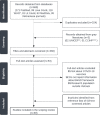Behavioural and social drivers of COVID-19 vaccination in Vietnam: a scoping review
- PMID: 38135311
- PMCID: PMC10748879
- DOI: 10.1136/bmjopen-2023-081134
Behavioural and social drivers of COVID-19 vaccination in Vietnam: a scoping review
Abstract
Background: Understanding of the behavioural and social drivers (BeSD) of vaccination is key to addressing vaccine hesitancy and accessibility issues. Vietnam's national COVID-19 vaccination programme resulted in high uptake of primary doses among adults, but lower booster doses for adults and primary doses for 5-11 years. This scoping review assessed BeSD influencing COVID-19 vaccine uptake in Vietnam to design interventions on reaching the national vaccination targets.
Method: We conducted a scoping review by searching PubMed, MedRxiv, LitCOVID, COVID-19 LOVE platform, WHO's COVID-19 research database and seven dominant Vietnamese language medical journals published in English or Vietnamese between 28 December 2019 and 28 November 2022. Data were narratively synthesised and summarised according to the four components of the WHO BeSD framework. The drivers were then mapped along the timeline of COVID-19 vaccine deployment and the evolution of the pandemic in Vietnam.
Results: We identified 680 records, of which 39 met the inclusion criteria comprising 224 204 participants. Adults' intention to receive COVID-19 vaccines for themselves (23 studies) ranged from 58.0% to 98.1%. Parental intention to vaccinate their under 11-year-old children (six studies) ranged from 32.8% to 79.6%. Key drivers of vaccination uptake were perceived susceptibility and severity of disease, perceived vaccine benefits and safety, healthcare worker recommendation, and positive societal perception. Commonly reported COVID-19 vaccines' information sources (six studies) were social and mainstream media (82%-67%), television (72.7%-51.6%) and healthcare workers (47.5%-17.5%). Key drivers of COVID-19 uptake remained consistent for both adults and children despite changes in community transmission and vaccine deployment.
Conclusion: Key enablers of vaccine uptake for adults and children included perceived disease severity, perceived vaccine benefits and safety and healthcare worker recommendations. Future studies should assess vaccine communication targeted to these drivers, national policies and political determinants to optimise vaccine uptake.
Keywords: COVID-19; SARS-CoV-2 Infection; Vaccination.
© Author(s) (or their employer(s)) 2023. Re-use permitted under CC BY-NC. No commercial re-use. See rights and permissions. Published by BMJ.
Conflict of interest statement
Competing interests: None declared.
Figures



Similar articles
-
Interventions to increase COVID-19 vaccine uptake: a scoping review.Cochrane Database Syst Rev. 2022 Aug 3;8(8):CD015270. doi: 10.1002/14651858.CD015270. Cochrane Database Syst Rev. 2022. PMID: 35920693 Free PMC article.
-
Determinants of COVID-19 vaccine hesitancy among parents in Ho Chi Minh City, Vietnam.Postgrad Med. 2022 Apr;134(3):303-308. doi: 10.1080/00325481.2022.2044142. Epub 2022 Feb 25. Postgrad Med. 2022. PMID: 35188041
-
Newness, unfamiliarity, and cultural beliefs; social and behavioural barriers to COVID-19 vaccination among the Dumagat Remontado, an Indigenous population in the Philippines.Health Place. 2025 May;93:103444. doi: 10.1016/j.healthplace.2025.103444. Epub 2025 Apr 4. Health Place. 2025. PMID: 40187120
-
Behavioural and social drivers of vaccination among child and adult migrants in Morocco: A qualitative interview study.Vaccine. 2025 May 22;56:127166. doi: 10.1016/j.vaccine.2025.127166. Epub 2025 May 3. Vaccine. 2025. PMID: 40319621
-
What Demographic, Social, and Contextual Factors Influence the Intention to Use COVID-19 Vaccines: A Scoping Review.Int J Environ Res Public Health. 2021 Sep 4;18(17):9342. doi: 10.3390/ijerph18179342. Int J Environ Res Public Health. 2021. PMID: 34501932 Free PMC article.
Cited by
-
Is disinformation more likely to spread? A fuzzy-set qualitative comparative analysis of emerging infectious diseases on China's short video platform.BMJ Open. 2024 Oct 21;14(10):e083351. doi: 10.1136/bmjopen-2023-083351. BMJ Open. 2024. PMID: 39433417 Free PMC article.
References
-
- Total COVID-19 vaccine doses administered. England and Wales: Our World in Data; 2023. Available: https://ourworldindata.org/grapher/cumulative-COVID-vaccinations [Accessed 29 Mar 2023].
Publication types
MeSH terms
Substances
LinkOut - more resources
Full Text Sources
Medical
Miscellaneous
